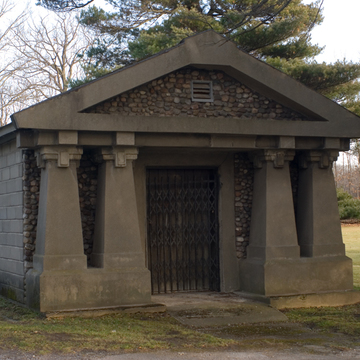This cemetery receiving vault was used to store bodies in winter when it was not feasible to bury them. Although designed in a residential style, it nonetheless evokes a solemn gravity appropriate to its function. The one-story vault has a broad, shallow gabled roof, is made of poured concrete, and is scored on its side walls to simulate coursed masonry. A pair of battered concrete columns flanks its oak double door and iron-grated entrance, supporting the pent-gable end. Cobblestone within the gable and on the front wall completes the overall bungalow with Egyptian styling. Riverside Cemetery, dating from the early nineteenth century, probably built this receiving vault during the heyday of ammunition manufacturing in Swanton village (1910–1920), when occasional blasts at the plants claimed dozens of lives.
You are here
Riverside Cemetery Vault
If SAH Archipedia has been useful to you, please consider supporting it.
SAH Archipedia tells the story of the United States through its buildings, landscapes, and cities. This freely available resource empowers the public with authoritative knowledge that deepens their understanding and appreciation of the built environment. But the Society of Architectural Historians, which created SAH Archipedia with University of Virginia Press, needs your support to maintain the high-caliber research, writing, photography, cartography, editing, design, and programming that make SAH Archipedia a trusted online resource available to all who value the history of place, heritage tourism, and learning.















